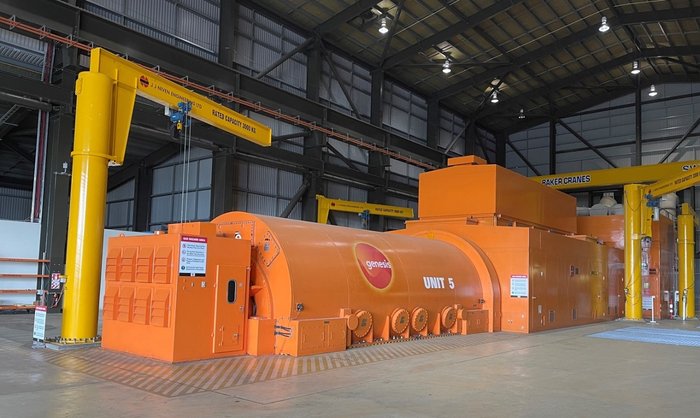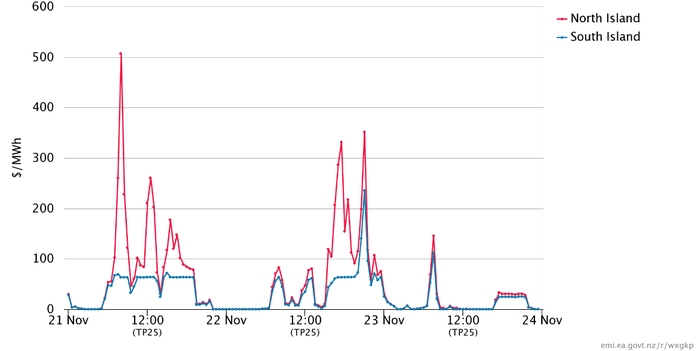Eye on electricity
New Zealand's geography and price separation
- Generation
- Prices

New Zealand is a long and thin country, filled with mountains, lakes, volcanoes, cities, and vast plains. This geography impacts New Zealand’s electricity sector.
Electricity in New Zealand is transported, using the national grid, from power stations to households, businesses, and large industrial users. The largest hydro power stations are in the South Island, while the bulk of New Zealand’s electricity demand is in the North Island. The North Island also contains all of New Zealand’s thermal and geothermal power stations, and the majority of New Zealand’s wind farms.
The High Voltage Direct Current (HVDC) lines electrically link the North and South islands. These large cables mostly transport electricity produced in the South Island up to cities in the North Island.
New Zealand’s wholesale electricity market uses locational marginal pricing, where the price at each location (or node) reflects the cost of transporting electricity to that location. This means that the price at each location is different. (For a good introduction to locational marginal pricing, see Transpower’s Market 101 - Part 2 Locational Marginal Pricing.)
Locational marginal pricing occurs because of losses or transmission constraints. As electricity is transported between locations, losses occur due to heat losses on the lines. The cost of this lost electricity is included in the price at each location.
Transmission constraints occur when the electricity transported over a line reaches the maximum capacity of that line. This can be exacerbated by outages of other lines to the same location – either planned or unplanned. This congestion on the grid also results in costs of transporting electricity to a location, which are included in the locational prices.
New Zealand’s unique geography sometimes means that wholesale electricity spot prices between the islands can be quite different. This is called price separation and is the result of transmission constraints (rather than losses). If price separation occurs, there are usually lower prices in the South and higher prices in the North. This type of price separation occurred in November 2022, as seen in Figure 1.

Price separation arose because of transmission constraints brought about by a number of contributing factors. Firstly, heavy rain in early November 2022 refilled many South Island hydro lakes. This allowed them to generate at high outputs with a low offer price1. It’s therefore been economic to generate a lot of electricity in the South and transport it North. This means the HVDC has been running hard – often up to the limit of what it can transfer (especially when wind has been low in the North Island).
Once this limit is reached, extra electricity for North Island demand is met using North Island generation, meaning the locational prices in the North Island will be set by more expensive North Island generation, while the lower priced South Island generation will still set the price at the South Island nodes.
The system must also carry reserves (generation on stand-by) to cover the sudden unexpected loss of the largest part of the system that could fail2.
Electricity and reserves are produced by the same generation stations ie, a power station can offer in both electricity and reserves for the same time period. The market then selects the optimal allocation for each power station between what it should generate and how much it should keep in reserve. This means that the need for increased North Island reserves reduces the amount of North Island generation capacity to supply electricity, which generally increases both North Island spot electricity prices and North Island reserve prices.
The HVDC can transfer reserves between the islands as well as electricity eg, it often uses cheap South Island reserves to help cover North Island generator risks. In that case it is the combination of electricity and reserve transfer that is constrained by the HVDC limit. This means that inter-island electricity and reserve transfer compete for capacity in a similar way to generator electricity and reserves, causing electricity and reserve price separation to occur simultaneously.
Another way high HVDC transfer levels can cause price separation is when the HVDC becomes the ‘risk setter’ ie, it is the largest part of the system that could fail. So, to cover the risk the HVDC poses, the North Island must have enough reserves available to cover an unexpected HVDC failure. Thus, the effective cost of using cheap South Island electricity to meet North Island demand is increased by the cost of North Island reserve3.
Other contributing factors to price separation during November have been North Island thermal and geothermal power station outages4. Geothermal power stations contribute cheap electricity, and their loss must be covered by more expensive thermal or hydro power. Also, the largest and most efficient Huntly thermal unit, Huntly 5 (see header image), was on outage with its generation being covered by more expensive thermal units. Since Huntly 5 is very large, its outage also contributed to the HVDC being the risk setter more often.
This complex spot price behaviour indicates that spot prices have reacted to changing underlying conditions. The Authority monitors spot prices, and instances of price separation, in our weekly trading conduct reports.
Image: Huntly Power Station Unit 5 uses natural gas as its fuel source and is able to generate up to 403MW of electricity.
1. See our explainer: Spot prices fall as hydro storage increases.
2. New Zealand’s electricity system is designed to cover the unexpected loss of the largest risk (called the ‘risk setter’), usually the biggest generator in each island or the HVDC. This is achieved by having reserves, or extra “just in case” generation, available in each island. See our explainer: Keeping the lights on with reserves.
3. Actually, it is usually the difference between North and South Island reserve prices, not just the North Island reserve price, because increasing North Island reserve means that less South Island reserve is required to cover North Island generator risks.
4. Read our explainer: When do power station outages occur?
Related News
New generation investment dashboard published
Our new generation investment dashboard provides a more dynamic and detailed picture of planned generation projects in New Zealand.
Additional consultation: Improving visibility of competition in the OTC contract market
We are undertaking additional consultation on our proposed clause 2.16 information notice to improve monitoring and transparency of the over-the-counter market.
Centralised wind and solar forecaster contract awarded
The Electricity Authority has awarded a contract to provide centralised wind and solar forecasting services to DNV Services.